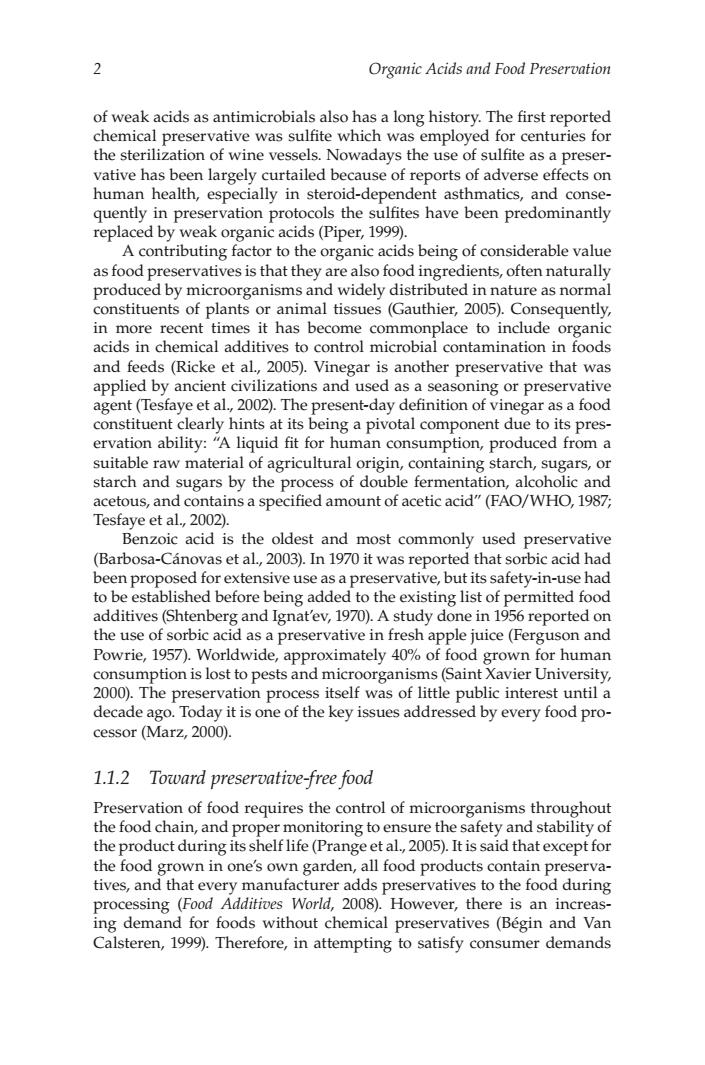正在加载图片...

Organic Acids and Food Preservation .The first reported ofwkcids as antimicob nod for centuries for ve was su whic n wa Nowadays the use of sulfite as a preser- vative has been largely curtailed because of reports of adverse effects on human health,especially in steroid-dependent asthmatics,and conse- quently in preservation protocols the sulfites have been predominantly replaced by weak organic acids(Piper,1999). A contributing factor to the organic acids being of considerable value as food preservatives is that they are also food ingredients.often naturally produced by microorganisms and widely distributed in nature as normal constituents of plants or animal tissues(Gauthier.2005).Conse nes it has beco me comm lace to include iaicomta mination in and fo eds (Ricke et al,20 applied another preservative that wa oy ancie seasoning or preservati agent (Tesfaye et al,2002).The present-day definition of vinegar as a food constituent clearly hints at its being a pivotal component due to its pres ervation ability:"A liquid fit for human consumption,produced from a suitable raw material of agricultural origin,containing starch,sugars,or starch and sugars by the process of double fermentation,alcoholic and acetous,and contains a specified amount of acetic acid"(FAO/WHO,1987; Tesfaye et al.,2002). Benzoic acid is the oldest and most commonly used preservative (Barbosa-Canovas et al.,2003).In 1970 it was reported that sorbic acid had ad for e,but its safety-in-use had stablished be tensive use ng dded g list of dditives nd Ignat'ev 1970 )A st the use o a preservative reporte juice(Ferguson and Powrie,1957).Worldwide,approximately 40%of food grown for human consumption is lost to pests and microorganisms(Saint Xavier University 2000).The preservation process itself was of little public interest until a decade ago.Today it is one of the key issues addressed by every food pro- cessor(Marz,2000). 1.1.2 Toward preservative-free food Preservation of food requires the control of microorganisms throughout the food chain and p monitoring to ensure the safety and stability of shelf life (Pra etal.2005).It is said that except for tives,and n in one's own garden all food products every manu e ac s to the proce ing (Foo World 2008 there s an increa ing demand for foods without chemical preservatives(Begin and Va Calsteren,1999).Therefore,in attempting to satisfy consumer demands 2 Organic Acids and Food Preservation of weak acids as antimicrobials also has a long history. The first reported chemical preservative was sulfite which was employed for centuries for the sterilization of wine vessels. Nowadays the use of sulfite as a preservative has been largely curtailed because of reports of adverse effects on human health, especially in steroid-dependent asthmatics, and consequently in preservation protocols the sulfites have been predominantly replaced by weak organic acids (Piper, 1999). A contributing factor to the organic acids being of considerable value as food preservatives is that they are also food ingredients, often naturally produced by microorganisms and widely distributed in nature as normal constituents of plants or animal tissues (Gauthier, 2005). Consequently, in more recent times it has become commonplace to include organic acids in chemical additives to control microbial contamination in foods and feeds (Ricke et al., 2005). Vinegar is another preservative that was applied by ancient civilizations and used as a seasoning or preservative agent (Tesfaye et al., 2002). The present-day definition of vinegar as a food constituent clearly hints at its being a pivotal component due to its preservation ability: “A liquid fit for human consumption, produced from a suitable raw material of agricultural origin, containing starch, sugars, or starch and sugars by the process of double fermentation, alcoholic and acetous, and contains a specified amount of acetic acid” (FAO/WHO, 1987; Tesfaye et al., 2002). Benzoic acid is the oldest and most commonly used preservative (Barbosa-Cánovas et al., 2003). In 1970 it was reported that sorbic acid had been proposed for extensive use as a preservative, but its safety-in-use had to be established before being added to the existing list of permitted food additives (Shtenberg and Ignat’ev, 1970). A study done in 1956 reported on the use of sorbic acid as a preservative in fresh apple juice (Ferguson and Powrie, 1957). Worldwide, approximately 40% of food grown for human consumption is lost to pests and microorganisms (Saint Xavier University, 2000). The preservation process itself was of little public interest until a decade ago. Today it is one of the key issues addressed by every food processor (Marz, 2000). 1.1.2 Toward preservative-free food Preservation of food requires the control of microorganisms throughout the food chain, and proper monitoring to ensure the safety and stability of the product during its shelf life (Prange et al., 2005). It is said that except for the food grown in one’s own garden, all food products contain preservatives, and that every manufacturer adds preservatives to the food during processing (Food Additives World, 2008). However, there is an increasing demand for foods without chemical preservatives (Bégin and Van Calsteren, 1999). Therefore, in attempting to satisfy consumer demands